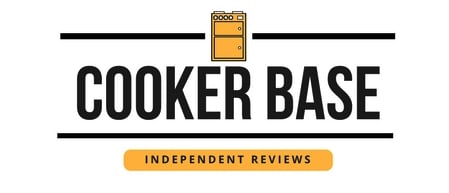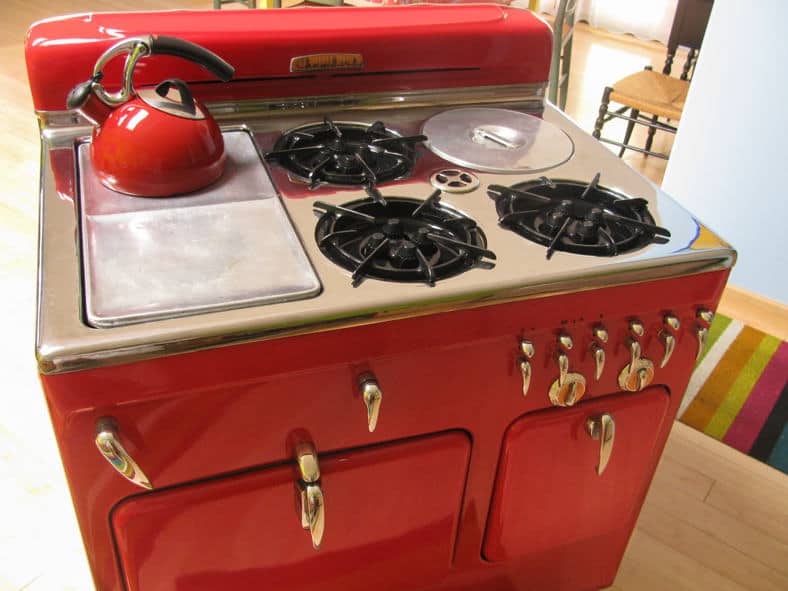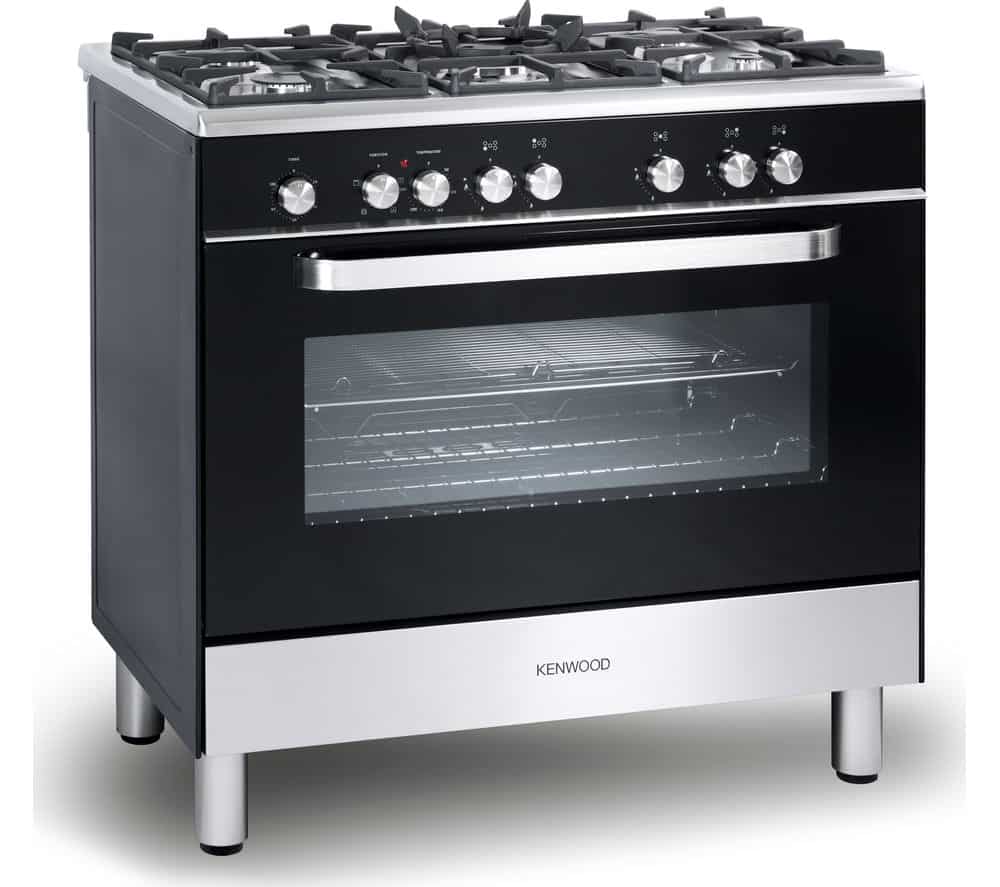The range has become the most desirable cooker available today. They’ve expanded from large, traditional aga cookers to become modern, fashionable and functional.
With any major purchase, it’s always important to do you your research to check that the product is right for you, but that’s particularly true of a range. Not only are they often significantly more expensive than standard cookers, but they can pack in many more features and additional choices.
Related Article: Best Range Cookers

The number of options is somewhat overwhelming, and it only takes a couple of minutes browsing range cookers on Currys or Amazon to see how little you know about what you need.
Trust me; I was that person!
I’m not going to say that I have all the answers as each person’s needs and wants are going to vary massively. But, the questions in this article should help you zero in on precisely what you need and give you some food for thought.
1) What’s your budget?
The budget is the first thing you must consider. These little beauties can get seriously expensive; some can even reach the tens of thousands of pounds mark. But the good news is that as they’ve got more popular, many range manufacturers have started to produce more affordable models.
Now, for less than £1000 there are some excellent range cookers available from well-known manufacturers like Kenwood and Logik.
In the last couple of years, even leading brands like Rangemaster and Belling have ventured into the budget range market. However, the downside is that there will often be compromises for the lower price.
These could be basic features, plastic fittings or even reduced power. With some careful investigation, you can get some excellent cookers for lower prices, but you may need to choose which features are important to you and which you’re willing to do without.
On the other hand, if you have a larger budget to spend, then there are some incredible high-end ranges available with exquisite finishes and more features than you’ve ever heard of. A range cooker can transform your kitchen and make larger meals with many dishes, more manageable than ever.
Range cookers for less than £1000 – At this price, you will have your choice of basic ranges with minimal extras. If you look carefully, you can find a quality cooker, but you may have to make do with some cheaper fixtures and fittings.
Range cookers between £1000 and £2000 – For less than £2000 you will be able to find excellent examples of some of the pricier brands including Rangemaster. You can make use of some advanced features like catalytic or pyrolytic liners, malfunction ovens and powerful induction or dual fuel options.
Range cookers for more than £2000 – Now you have your pick of the top of the range models. At this price, the stoves available to you will have reached professional standards. They will either be packed with features, provide impressive power or stunning design.
It’s essential to investigate each cooker thoroughly before you make your purchase because a higher price may provide you with more options, but it doesn’t always guarantee better quality.
Top Tip – Refurbished cookers are a great alternative to grab a bargain. There are plenty of places that offer them these days, and it’s an excellent way to save a good chunk of money.
Reputable companies will be able to show you the defects (most often cosmetic and usually minor) and provide a 6-12 month guarantee.
Related Reading: Best Value Range Cookers
2) What size cooker do you need/ want?
Range cookers come in a variety of sizes these days. Generally, in the UK, they start from 90cm and work their way up to around the 110cm mark. You can, of course, get bigger than this, but they are likely to be designed for commercial kitchens.
You will first need to decide how much room you have to work with. Are you renovating your kitchen? Can you create room? Is the space for your cooker fixed? Are you upgrading your old cooker?

If you’re working through a kitchen renovation or even starting from scratch in a new home, then you should be able to take your pick of sizes. If you have a fixed width, then your choices will be more restricted, but not final.
Only recently a friend of mine paid £100 to a local handyman to remove 15cm from the cupboards on each side of the cooker space in his kitchen. For someone who knew how, it was a simple job and enabled my friend to go from a standard 60cm model to a 90cm range. This may not be suitable for everyone, but it’s worth not overlooking the fact that if you don’t have enough space, you may be able to create it.
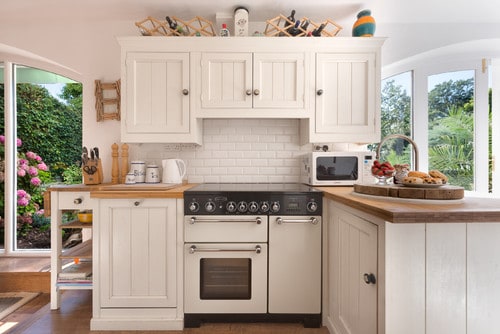
To give you an idea of what to expect here are some examples of what some ranges come with at each size:
90cm range cooker – Budget ranges at this size may have just one oven, but for a higher price, you can likely get two ovens or two ovens and a separate grill. Most will be arranged with the main oven and grill on one side with an extra-tall second oven on the other. The hob is most likely to have four or five burners.
Related Article: Best 90cm Induction Range Cookers
100cm range cooker – The most common ranges in this size will have two large ovens or two ovens and a grill. However, for a little more money, you can find some with four compartments. On the hob, you will probably find five or six burners.
110cm range cookers – Most ranges of this size will have four compartments and anywhere from six to eight hob burners. The compartments could include anything from two ovens, a grill and a storage drawer, to three ovens and an oven/grill combo.
Related Article: Best Value 110cm Range Cookers
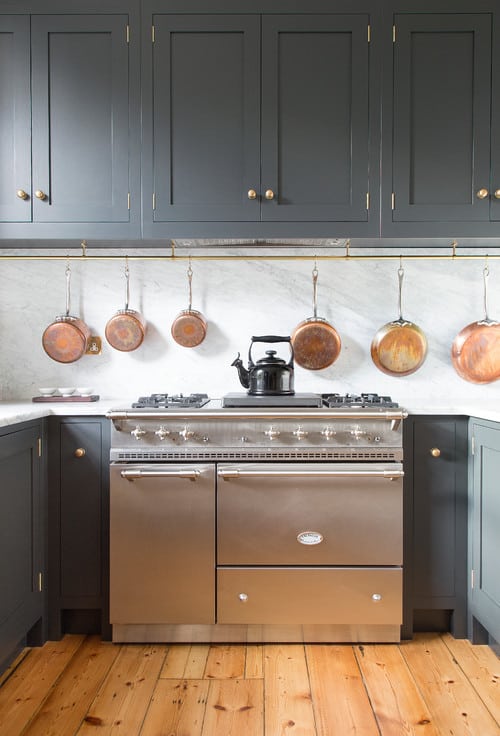
If I could choose, a 100cm range would be about the right fit for most. It’s not too big, and the price points for this size of cooker offer excellent value in my opinion.
3) What fuel will you use to power your cooker?
There are two main ways to power your cooker; gas and electric. But you can also find units that combine them both known as ‘dual fuel’ and electric cookers with ‘induction’ hobs.

The cheaper of these is gas, and I think they offer the best route for the hob because of the instant heat and responsive temperature controls.
Gas Range Pros and Cons
Pros
- The hob and oven are both fast to heat and responsive to quick temperature changes
- Being able to see the flame makes it easier to control the heat precisely
- Can be cheaper than other cookers
- Can be used with all types of cookware
Cons
- Some require fiddly manual ignition
- The hob can build up thick burnt on spills
- Require a gas supply in your kitchen
- Must be installed by a gas engineer
Related Article: Best Gas Range Cookers

Electric works out to be a little more expensive to run than gas. I find that electric cook tops often take a little longer to heat up and aren’t as easy to control. But an electric oven is by far the best option from the two as, ironically, it allows you to control the heat better and provides an even, consistent temperature.
Electric Range Pros and Cons
Pros
- Can come with an easy-clean, smooth top
- Sometimes the hob features double or triple zones for larger pans
- Can be used with all types of cookware
- They don’t heat your kitchen as much as gas cookers do
- Flat electric hobs are more stable for pots and pans
- They are often quicker and easier to install
Cons
- The burners cool slowly making them less responsive to quick temperature changes
- Glass topped hobs can scratch or stain easily
- With some models it can be hard to tell when the hob is still hot
- They often use more energy than gas cookers
But, the winner for me would have to be a dual fuel option. This means that you have a gas hob and electric oven, essentially getting the best of both worlds.
The number of dual fuel cookers is growing exponentially. It has become the most popular choice and for serious cooks, I would say it’s a must.
Dual Fuel Range Pros and Cons
Pros
- Has a responsive gas cook top
- An evenly heated electric oven
- Combines the benefits of gas hobs and electric ovens
Cons
- These ranges can be more expensive than gas or electric versions
- Require a gas supply in your kitchen
- Must be installed by a gas engineer
Related Article: Best Dual Fuel Range Cookers
If you do decide to go down the gas or dual fuel route, then you will need to bear in mind that you will have to have the cooker professionally installed by a certified gas engineer. This is definitely NOT an area that you want to try your DIY skills out on.
The price for installation will vary, and we were quoted anything from £50 up to £150. Many cooker retailers offer a combined rate for delivery and installation.
If you can’t get gas, then you are stuck with electric. This isn’t always a bad thing though, and the electric hobs are so much better than they used to be.
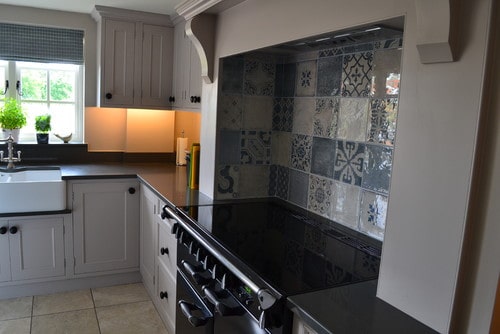
If your budget will stretch, then I would say it’s worth considering an induction hob. I think they work just as well as gas, but the fact you need to buy specialist pots and pans is a bit of a pain.
Induction Range Pros and Cons
Pros
- Has an easy clean smooth top
- The hob surface doesn’t heat up, so spills don’t cook on to the surface
- The oven is the same as those in electric cookers
- Fast to heat and responsive temperature control
Cons
- May buzz at higher settings
- May click at lower settings
- Can be more expensive
- They don’t work with all cookware.
4) What will you use the cooker for?
Working out what you’re going to be using the oven for is another key point that you need to consider.
For example, do you bake a lot? Do need constant use of the grill? Do you have a big family and need a lot of space? Are you looking for speed for things like boiling water, stir-fries or griddle pans? Do you need it to have a timer for your food?
The list could go on, but if you spend a little time jotting down what it’s going to be used for and which features you may need it will really help.
It’s best to try to think of each time you’ve turned your cooker on over the last two weeks. This will help you to spot any trends or special requirements.
In my home, we spend a lot of time baking with the kids. It could be anything from biscuits to soufflés and everything in between. For this, we need accuracy, because, for some items, just 10 degrees off could spoil the results, so this was our main priority.
We also enjoy cooking Sunday roasts for our extended family and friends, which is why we opted for a range cooker in the first place. So, we needed space. As a result, we decided that we could do without the warming draw that many 100cm+ range cookers have and instead replace it some more cooking room.
My wife and I then used this list of accuracy, 100cm range, and extra oven space to narrow down the potential ranges to choose from.
| Main need | Cooker type |
|---|---|
| Accuracy | Electric fan ovens offer a more consistent heat, which means less offset in temperature around the oven. |
| Speed | Smaller cookers will be quicker to heat up. Hobs with more powerful gas ratings will be a good choice. |
| Grilling | Larger grill ovens with adjustable racks. Elements in the oven should cover a large surface area. |
| Boiling and simmering | Induction cookers are a great choice for this with their instant heat and powerful currents. |
5) What style do you want for your cooker?
Ideally, your cooker should work in harmony with the style of your existing kitchen. The easiest place to start is simply between modern and more traditional cookers

Don’t be too afraid to mix things up though. The picture above shows an old-school aga blending in splendidly with a modern style kitchen. Sometimes rules are there to be broken!
For modern style cookers, I’d be looking at brands like Stoves or Smeg. Some of them look as if they’re right out of the Starship Enterprise!

The more traditional style of kitchen tends to favour a more traditional style cooker. These often have bevel edges, big cooker tops and tons of space.
There are, of course, plenty of other different styles of range cookers to choose from, but don’t be too afraid on mixing it up a little as the juxtaposition of contemporary and traditional can often have the most striking effect.
6) How many cooking compartments do you need?
The size of your cooker will often play a pretty significant role in terms of the number of compartments your stove might have. Most ranges have anything from one oven to four or five multi-use cavities.
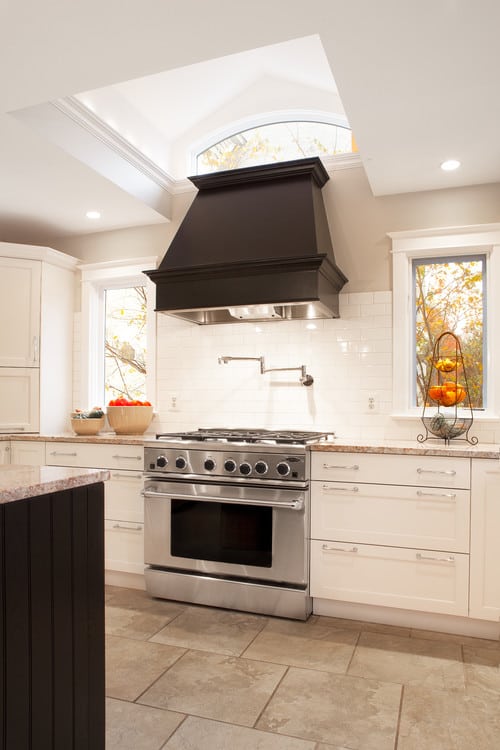
I like the use of having at least 2 to choose from because, for me, the whole point of having a range cooker is to increase the space and to give me more options.
It would help if you then considered what you need each of the cavities to do. For example, do you want a fan oven, conventional oven, grills, warming racks, tall ovens? If you shop around you can find that some of the grills double up as a conventional oven as well, giving you even more room for use.
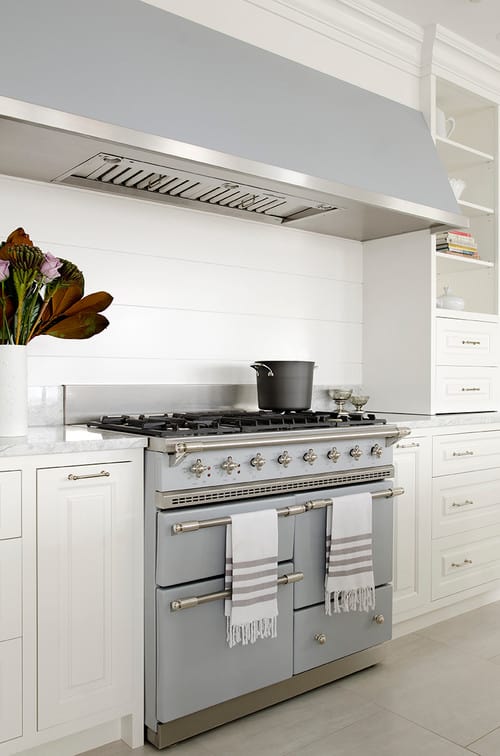
A word of warning with your layout, I’ve found that some range cookers with the main oven at the bottom can be tough to see inside. To check how your dinner is progressing, you may have to bend right down or drop onto one knee.
Also, be wary of models that include an odd-shaped cavity. Sometimes in an effort to add on more functions, you get a grill that’s so narrow it’s almost unusable.
7) Do you need help cleaning your oven?
Of course, you do!
Cleaning an oven is a time-consuming chore and is often overlooked when selecting your oven.
“Whilst all the gizmos and technology in the world help, there is no substitute for a bit of elbow grease”
Unfortunately, there are no oven features that can completely remove the need to clean your oven. Even those with ‘self-cleaning’ functions will need to be wiped out regularly and may still require scrubbing every once in a while.

However, some things can aid the process:
Catalytic liners
Catalytic liners are sheets of porous ceramic that can be installed inside an oven to absorb grease and grime. A lot of the mid to high-end cookers have these, and they can really cut down on the time it takes to give your oven a good clean.
Pyrolytic ovens
Pyrolytic cleaning is a function that some cookers have that super-heats the oven to incinerate any grease and debris. Special liners are included that assist this process. They are similar to catalytic liners but don’t absorb the grease.
Vapour cleaning
This is a function that I first came across in the Smeg range of cookers, but I believe several companies now offer this feature. A small amount of water is released into the cooker to create steam. The steam is then heated to drive it onto any dried-on food in the oven. When the steam cycle is complete, the mess can then be easily wiped away.

8) Which colour should I choose?
The colour of your cooker can add wow-factor. Gone are the days of only choosing between black or silver, while these two colours are still great, there are now so many more to choose from. Common colours include red, blue, cream, silver, chrome and even orange.
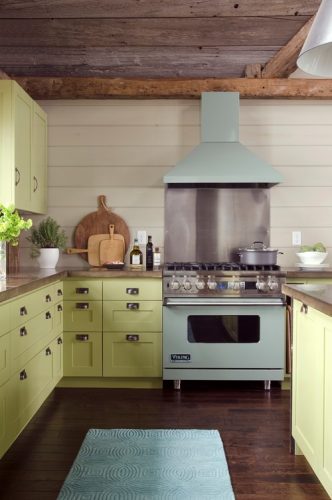
The great thing is that the colour of your new cooker doesn’t need to necessarily match your kitchen. Creating bold contrasts can also be an effective way of drawing the appearance of your cooker into the complete design of your kitchen. The beauty of a brightly coloured cooker is that it takes it from just being another home appliance to being the stunning focal point of your kitchen.

I’ve seen some bland kitchens really brought to life with a bright red cooker from Smeg. The flip side is that I’ve also seen bright kitchens, busy with colour look incredible contrasted with a matt black range cooker. When it comes to colour, the sky is the limit for range cookers, and I say, go to town!
Top Tip – Don’t forget to accessorise your cooker with your cooker hood and your back-splash. If you’ve decided for more neutral tones (black and silver), use a lighter shade of tile for the backsplash. Patterned tiles work great too!

9) What extras do I need with my cooker?
This is something that will be totally personal to you. There are plenty to choose from, so I’m going to list up some of my ‘must-have’ features for you to consider.
Griddle – A griddle provides you with a hot plate on top of the range. It’s great for things like steaks, chicken, pancakes and eggs. They are generally flat, although some do come with ridges.

Warming draw – A warming tray is often found at the bottom of the cooker and uses the residual heat from the oven above it. Some of the higher-spec ranges will allow you to maintain the temperature in these, although the majority won’t ever get too hot.
Wok burner – The wok burner is another feature that I’m starting to see on more range cookers these days. It’s an extra-large hob burner that allows you to get your wok piping hot.
Plate racks – Plate racks allow you to store plates upright within the oven to keep them warm. If your range has a good number of cavities, then you can set one aside for this.
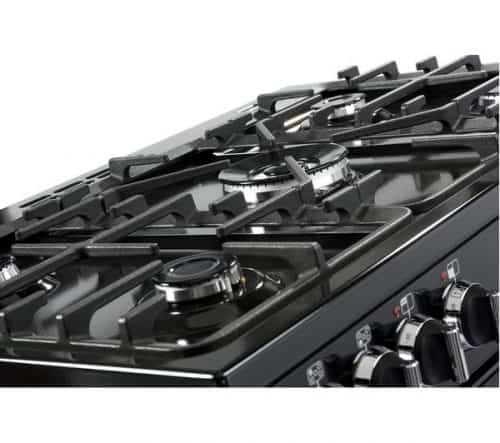
Door racks/ handyracks – You’re able to get shelves that are fitted to your oven door so that when you open the door, the rack and anything on that rack pulls out. It’s similar to those clever corner cupboards from Ikea and something that you didn’t think you need until you try them. They are particularly useful when used with roasting trays to make basting extra simple.
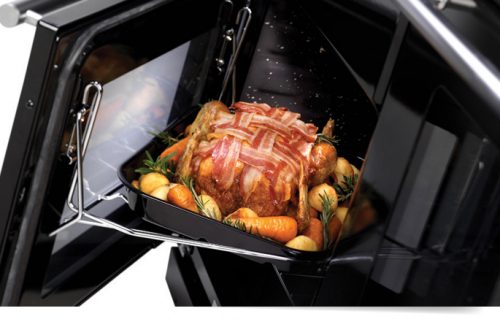
Conclusion
Hopefully, this guide will both ask and answer some of these crucial questions before you buy your range cooker.
The list isn’t exhaustive by any means, but it’s something I wish I’d been able to access before making my own range purchase.
If you think I’ve missed something or if you have any questions, then feel free to drop me a message below and I’ll be happy to answer them.
